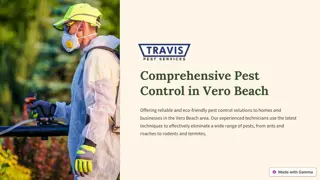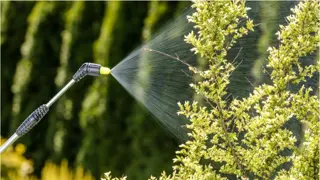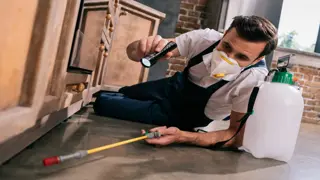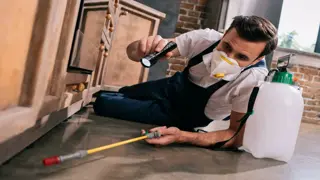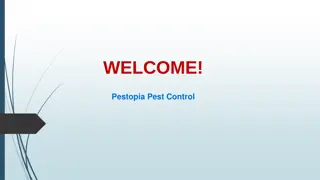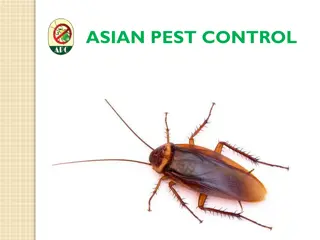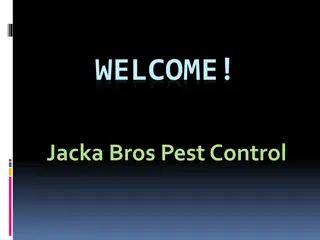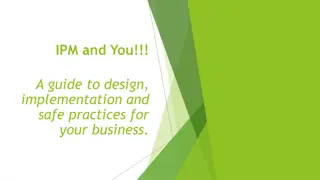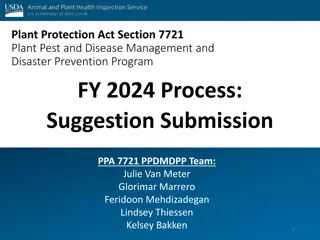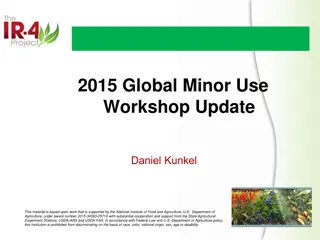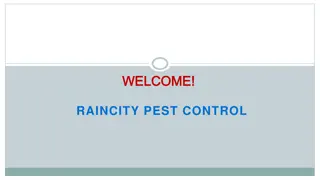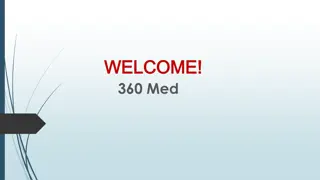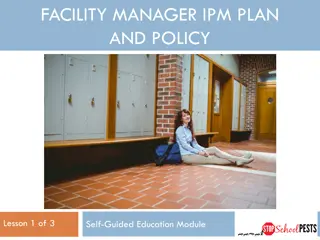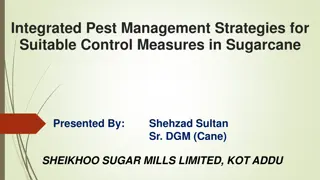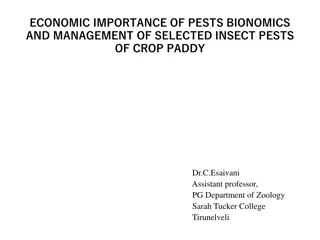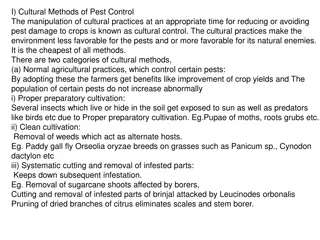Integrated Pest Management in Food Service Operations
Integrated Pest Management (IPM) is essential for preventing and controlling pests in food service operations. This approach focuses on denying pests access to the operation, food, and shelter, while working with licensed Pest Control Operators (PCOs) to eliminate any pests that do enter. By implementing IPM programs and following key strategies, such as using air curtains, screens, and sealing openings, businesses can effectively manage and prevent pest infestations, safeguarding customers and maintaining a clean environment.
Download Presentation

Please find below an Image/Link to download the presentation.
The content on the website is provided AS IS for your information and personal use only. It may not be sold, licensed, or shared on other websites without obtaining consent from the author.If you encounter any issues during the download, it is possible that the publisher has removed the file from their server.
You are allowed to download the files provided on this website for personal or commercial use, subject to the condition that they are used lawfully. All files are the property of their respective owners.
The content on the website is provided AS IS for your information and personal use only. It may not be sold, licensed, or shared on other websites without obtaining consent from the author.
E N D
Presentation Transcript
Chapter Number 13 Integrated Pest Management Class Name Instructor Name Date, Semester Book Title Book Author 1
Learning Objectives After this presentation, you should be able to complete the following Learning Outcomes 13.0 Methods for denying pests access to an operation 13.1 Methods for denying pests food and shelter 13.2 Signs of pest infestation and activity 13.3 13.4 How to correctly store pesticides How to select a pest control operator (PCO) 13.5 2
13.0 KEY TERMS Pest control operator (PCO): Licensed professional who uses safe, current methods to prevent and control pests. Air curtains: Devices installed above or alongside doors that blow a steady stream of air across an entryway, creating an air shield around open doors. Insects avoid them. Also called air doors or fly fans. Pesticides: Chemicals used to control pests, usually insects. Infestation: Situation that exists when pests overrun or inhabit an operation in large numbers. Integrated pest management (IPM): Program using prevention measures to keep pests from entering an operation and control measures to eliminate any pests that do get inside.
Methods for denying pests access to an operation 13.1 INTEGRATED PEST MANAGEMENT (IPM) PROGRAMS Pests, such as insects and rodents, can pose serious problems for restaurants and foodservice operations. Beyond being unsightly to customers, they damage food, supplies, and facilities. The greatest danger from pests is that they can spread diseases, including foodborne illnesses. Once pests have entered the operation in large numbers an infestation they can be difficult to eliminate.
Methods for denying pests access to an operation 13.1 Developing and implementing an integrated pest management (IPM) program is the key to keep pests from entering the operation and control measures to eliminate those that do get inside. An IPM program has three basic rules: 1 Deny pests access to the operation. 2 Deny pests food and shelter. 3 Work with a licensed PCO to eliminate pests that do enter.
Methods for denying pests access to an operation 13.1 DENYING PESTS ACCESS TO THE OPERATION Pests can enter an operation by traveling inside with deliveries or byentering through openings in the building itself. Deliveries Doors, windows, and vents Screens Self-closing devices and door Air curtains Exterior openings Pipes Concrete Screens Grates Floors and walls
Methods for denying pests food and shelter 13.2 DENYING FOOD AND SHELTER Pests are attracted to damp, dark, dirty places. A clean operation offersthem no food or shelter. Maintain the following: Garbage areas Recyclable areas Storage areas Continuous dleaning
13.3 Signs of pest infestation and activity GROUNDS AND OUTDOOR DINING AREAS Birds, flies, bees, and wasps can be both annoying and dangerous to your customers. As with indoor pests, the key to controlling them is to deny them food and shelter. Here are some guidelines: Mow the grass, pull weeds, get rid of standing water, and pick up litter. Cover all outdoor garbage containers. Remove uneaten food and dirty dishes from tables. Clean dishes as quickly as possible. Clean spills as quickly as possible. Do not allow staff or customers to feed birds or wildlife on the grounds. Locate electronic insect eliminators, or zappers, away from food, customers, staff, and serving areas. Call your PCO to remove hives and nests.
13.3 Signs of pest infestation and activity IDENTIFYING PESTS Pests may still get into your operation even if you try to prevent them. They hide in delivery boxes and even ride in on staff s clothing or personal belongings. It is important to spot signs of pests and determine which type you aredealing with. When you detect pests, record the date, time, and location. Then inform your PCO. Early detection allows the PCO to start treatment as soon as possible.
13.3 Signs of pest infestation and activity IDENTIFYING PESTS: SIGNS OF ROACHES Roaches generally feed in the dark. If you see a cockroach in daylight, you may have a major infestation, because only the weakest roaches come out during the day. and If you suspect you have a roach problem, check for the following signs: Strong oily odor Droppings (feces) that look like grains of black pepper Capsule-shaped egg cases that are brown, dark red, or black possibly leathery, smooth, or shiny in appearance
13.3 Signs of pest infestation and activity IDENTIFYING PESTS: SIGNS OF RODENTS Rodents are a serious health hazard. They eat and ruin food, damageproperty, and can spread disease. A building can be infested with both rats and mice at the same time. Look for the following signs. Gnawing Droppings and urine stains Tracks Nesting materials Holes
13.4 How to correctly store pesticides PROPER STORAGE OF PESTICIDES All pesticides used in your facility should also be stored by your PCO. If they are stored on the premises, follow these guidelines: Keep pesticides in their original containers. Store pesticides in a secure location away from where food, utensils, and food equipment are stored.
13.4 How to correctly store pesticides PROPER DISPOSAL OF PESTICIDES Pesticides should be disposed of by the PCO. Check regulatory requirements before disposing of pesticides yourself. Many are considered hazardous waste. Dispose of empty containers according to manufacturers directions and your regulatory requirements.
How to select a pest control operator (PCO) 13.5 WORKING WITH A PEST CONTROL OPERATOR (PCO) Few pest problems are solved simply by spraying pesticides chemical agents used to destroy pests. While you can help reduce the risk of infestation, most pest control should be carried out by professionals. You can rely on your licensed PCO to do the following to prevent or eliminate pests: Develop an integrated approach to pest management. This may include a combination of chemical and nonchemical treatments to solve and prevent problems. Stay current on new equipment and products. Provide prompt service to address problems as they occur. Contracts should include regular visits as well as immediate service when pests are spotted. Keep records of all steps taken to prevent and control pests.
How to select a pest control operator (PCO) 13.5 HOW TO CHOOSE A PCO Check references when hiring a PCO and make sure they are licensed (if required by your state). Always require a written service contract that outlines the work to be performed. Here are some things included in a service contract: Description of services to be provided, including an initial inspection, regular monitoring visits, follow-up visits, and emergency service Period of service Your duties, including preventive measures and facility preparation before and after treatment
How to select a pest control operator (PCO) 13.5 HOW TO CHOOSE A PCO Records to be kept by the PCO include: Pests sighted and trapped; species, location, and actions taken Building and maintenance problems noted and fixed Facility maps or photos showing locations of traps, bait, and problem spots Schedule for checking and cleaning traps, replacing bait, and reapplying chemicals Regular written summary reports from the PCO







